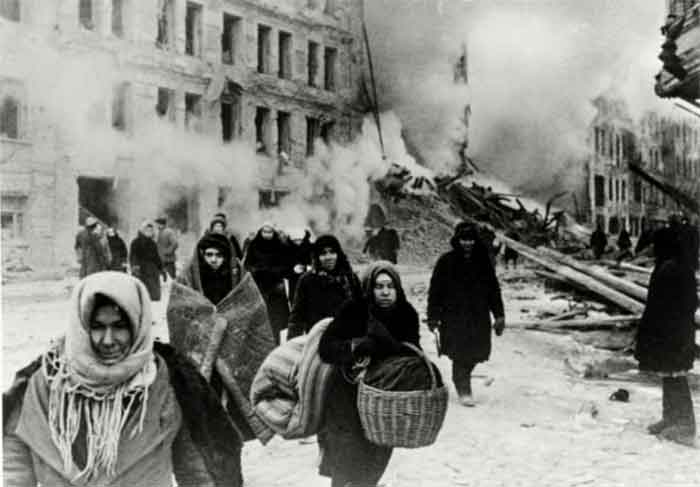
80 years ago, Soviet troops battled to open up a narrow corridor to the besieged city of Leningrad. A railroad was constructed through it in literally two weeks and supplies started reaching a city that had been bled dry.
The Red Army only had to traverse a distance of 15 km. Stillt this short distance was at the cost of the lives of thirty thousand Soviet soldiers.
This turn of events played major role in shaping the destiny or determining the path of the Great Patriotic War.
Courage and endurance scaled heights almost unparalleled in history in withstanding and overpowering an oppressor.
It was remarkable how the Soviet red army resurrected itself from the darkest waters to peg back at the enemy.
Marxist Leninist ideology played a major role in the Soviets constructing a path in breaking the German encirclement.
It proved the deep penetration of the red army in the Soviet people and the high level of political consciousness of the Soviet people.
Innovation in military practice was scaled to heights rarely transcended when procuring supplies to the people by penetrating enemy barriers as well as mobilising people in support of actions in resisting the enemy.
It exhibited the sheer brilliance of the military tactics and planning of the Red Army in overpowering the enemy against all odds. With great mastery it garnered every possible force to deliver a striking blow to the enemy.
Establishing supply links
After Nazi Germany invaded the Soviet Union in June 1941, German armies had by early September approached Leningrad from the west and south while their Finnish allies approached to the north down the Karelian Isthmus. Leningrad’s entire able-bodied population was mobilized to construct antitank fortifications along the city’s perimeter in support of the city’s 200,000 Red Army defenders. Leningrad’s defenses soon stabilized, but by early November it had been almost completely encircled, with its entire essential rail and other supply lines to the Soviet interior cut off.
On September 8, 1941, the forces of Germany’s Army Group North captured the town of Shlisselburg on Lake Ladoga, thus accomplishing the encirclement of Leningrad by land. More than 2.5 million inhabitants and about 500,000 soldiers of the Red Army lay trapped in the city.
A water route across Lake Ladoga,was the only link to the city, encircled as it was by German and Finnish troops, to the “mainland”. This “Road of Life” was used for sending food and ammunition to Leningrad and evacuating its population.
However neither the “Road of Life”, which was under continuous enemy shell fire, nor Soviet transport aviation were capable in offering full-scale supplies to the large metropolis. In the winter of 1941, Leningrad was stained with severe starvation. People fainted from exhaustion right in their very workplaces, cases of cannibalism were recorded and the presences of hundreds of corpses strewing the streets were a routine occurrence.
In 1941 and 1942, the Red Army persisted in breaking the siege of the city but, due to a lack of coordination among military units and insufficient manpower, resources and combat experience, these attempts turned futile.. At the same time, the constant pressure that Soviet troops placed on Army Group North prevented the German command to transfer their reserves from Leningrad to other sectors of the front.
The inhabitants of the city on the Neva River welcomed the New Year of 1943 with much better prospects than a year earlier: Subsidiary farms had been organized in the unoccupied suburbs, bread rations were increased, public transport were restarted partially and houses had electricity for a few hours a day.
Nevertheless, Leningrad still witnessed gross suffering, as the siege maintained its stranglehold. “We shall continue to walk with you, Leningrader, through the cold and the battles, through the fire, mud and blood, the groans and the gnashing. We shall still have our fair share of ordeals to live through. Let our fraternal solidarity be even stronger! Prepare to strike!” recited a New Year speech by writer Vsevolod Vishnevsky.
The ensuing German blockade and siege too the toll for 650,000 Leningrader lives in 1942 alone, mostly from starvation, exposure, disease, and shelling from distant German artillery. Sparse food and fuel supplies reached the city by barge in the summer and by truck and ice-borne sled in winter across Lake Ladoga.These supplies enabled the city’s arms factories operating and its two million inhabitants to barely survive,being most frugal. In 1942, while one million more of its children, sick, and elderly were in the process of being evacuated, Starvation-level food rationing was reduced by establishing new vegetable gardens that encompassed most open ground in the city by 1943.
Launching Offensive
Preparations for embarking on a strike were, were underway. After the sensational November success of Soviet troops at Stalingrad and the changed strategic situation on the Soviet-German front, the Supreme High Command Headquarters took the decision to launch a large-scale offensive codenamed ‘Operation Iskra’ (‘Spark’) to break the blockade. Aimed for January 1943, the offensive was planned to take place in the area of the Shlisselburg-Sinyavino salient – only 15 km separated the defenders of the city from the “mainland” there.
The plan was for the troops of the Leningrad Front under General Leonid Govorov to break the encirclement from the inside, while the forces of the Volkhov Front under General Kirill Meretskov would break through from the outside to meet them.
The strike groups numbered about 300,000 men, while the Germans had only 60,000 available in the salient. Also, the Soviet troops establishd a sixfold superiority over the enemy in artillery, tenfold in tanks and twofold in aircraft.
It was an arduous task to cross these 15 km, however. In the years of the siege, the Wehrmacht had converted he territory into a highly fortified zone with many strongpoints, while the almost impenetrable marshy terrain between them was strewn with barbed wire entanglements and endless mine fields.
Soviet troops spent the whole of December preparing in full earnest for ‘Operation Iskra’. In training camps in the rear, members of assault units and subunits struck at specially-built German defensive positions.
“It was a particular concern for us that the preparations for the breakthrough operation should be kept under wraps,” stated the deputy commander of the Volkhov Front, General Ivan Fedyuninsky. “The troop regrouping was conducted strictly at night or in non-flying weather. Only those units and subunits that were immediately adjacent to the enemy took part in probing actions and night reconnaissance. These measures paid dividends. The enemy only managed to establish that our troops were getting ready for an offensive shortly before the start of the operation and, even then, the Nazi command could not determine the timing and force of the attack.”
It was planned to ignite the spark” on New Year’s Day of 1943, but the operation had to be postponed slightly, because of a everlasting thaw. Finally, on the morning of January 12, the Soviet artillery and aviation launched a full scale offensive to destroy enemy positions. “To this day, I can’t forget the impression left on me by the devastating fire of the Russian guns,” stated German soldier Wilhelm Lahmeyer. “When I recall that entire infernal din, the detonations of shells and mortars, it makes my flesh creep again and again.”
Subsequently, the troops of two fronts simultaneously launched an offensive. Advancing from the direction of Leningrad, the units crossed the Neva River, which had frozen by this time, and proceeded to extinguish the enemy from nearby populated areas.. The thin ice offered no space for heavy and medium tanks, so the soldiers were forced to use light T-60s and T-26s, as well as ordinary armoured vehicles. One of the T-60s heroically overpowered two of the newest German PzKpfw VI ‘Tiger’ heavy tanks into the line of fire of Soviet artillery and they were rapidly destroyed. Another “predator” that was entrapped in peat and had been abandoned by its crew was seized in no time in perfect condition..
Slowly, but with high conviction and zeal, the troops of the Volkhov Front proceeded even as the enemy garnered all possible reserves to overpower them. By January 14, bitter fighting erupted for Shlisselburg and, on the morning of January 18, a historic event crystallised. Units of the Volkhov Front’s 2nd Shock Army met up with units of the 67th army of the Leningrad Front near Workers’ Settlement No. 1.
“I witnessed the joy with which soldiers of the fronts that had broken the siege rushed towards each other. Ignoring the enemy artillery shells arriving from the direction of the Sinyavino Heights, the soldiers firmly and fraternally embraced each other. It was a truly hard-won joy!” recalled Georgy Zhukov, who was present at an observation post of the 2nd Shock Army command. During ‘Operation Iskra’, the commander was coordinating the operations of the two fronts.
The Soviet troops turned southwards, with the goal of intensifying the offensive further, but, in the end, they were unsuccessful and were forced to go on a retreat.. Nevertheless, a direct land route to and from the city had been re-established. It had cost the lives of 33,000 Red Army soldiers 12,000 German soldiers.
Construction of a railroad immediately began in the corridor that had been cleared – it was a strip just 11 km wide. The railroad became known as the ‘Road of Victory’. The first train carrying food supplies arrived in Leningrad on February 7.
Inspite the fact that it would still be another year before the siege was fully eradicated the long-suffering city could finally gain respite. “The siege has been broken. We have spent a long time waiting for this day. We always believed it would come,” writer Olga Bergholz told Leningraders in a radio broadcast. “Our bodies swelled and went black from starvation, we collapsed from exhaustion on streets disfigured by the enemy and it was only our belief that the day of liberation would come that kept us going. And each one of us, as we looked death in the face, toiled for the sake of our defence, for the sake of the life of our city and each of us knew that the day of reckoning would dawn and that our army would break through and lift the arduous siege.”
Soviet offensives in early 1943 broke the German encirclement and paved way for more substantial supplies to reach Leningrad along the shores of Lake Ladoga. In January 1944 a successful Soviet offensive drove the Germans westward from the city’s outskirts, bringing the siege to a conclusion. The Soviet government awarded the Order of Lenin to Leningrad in 1945 and bestowed the title Hero City of the Soviet Union on it in 1965, thus paying tribute to the city’s successful role in one of the most fierce and memorable sieges in history. A monument commemorating the victims and heroism of the siege was unveiled in 1975.
Harsh Thakor is freelance journalist who has extensively studied Liberation Movements. Owes gratitude to ‘Russia Beyond.’ In ‘How the red Army Broke the Seige of Leningrad.’










































